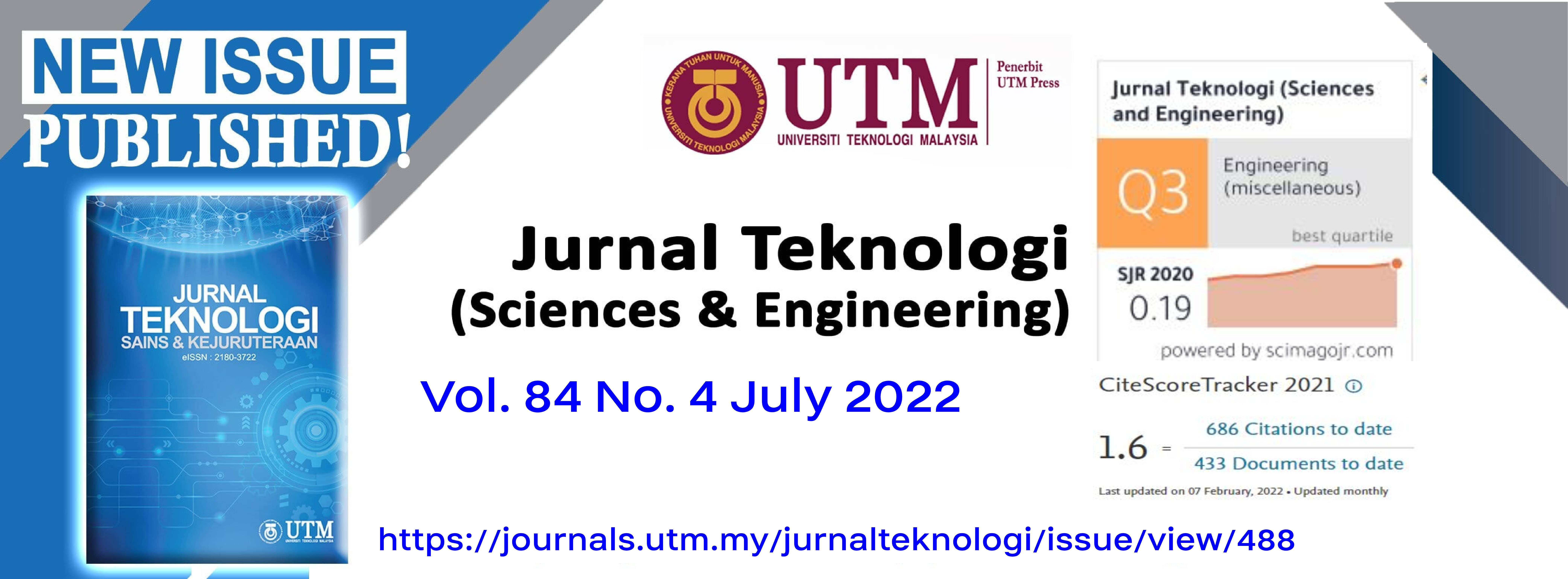THE EFFECT OF THREE DEPTHS OF SUBSURFACE DRIP IRRIGATION LEVELS WITH TWO TYPES OF SOIL ON THE PERCENTAGE OF SOIL MOISTURE CONTENT
DOI:
https://doi.org/10.11113/jurnalteknologi.v84.17961Keywords:
Subsurface drip irrigation, sandy soil, silty loam soil, moisture content, radishAbstract
The experiment was carried out in the educational nursery field of Department of Plant Production Technologies / Mosul Technical Institute during the agricultural season 2019-2020, to study two factors; the first is studying the effect of three depths, 5 cm (T1), 10 cm (T2) and 15 cm (T3), using Subsurface Drip Irrigation (SDI) The second factor is studying two types of sandy and silty loam soil on the soil moisture content and on some characteristics of the vegetative growth and yield of radish plants. The results show that the best depth of subsurface irrigation pipes was at treatment T3 (15 cm), where the highest values of moisture content at treatment T3, and the percentage of increase of the humidity before and after irrigation when the treatment (T1, T2, T3) is (10%, 12%, 16.3%) for the silty loam soil. As for sandy soils, it is shown that the percentage increase of moisture before and after irrigation when the treatment (T1, T2, T3) is ( 11.6%, 16%, 22.9%); meaning that the highest increase of moisture content is at Treatment T3, and this is due to evaporation from the ground surface decreases as the depth of wet soil increases, as well as the depth of 15 cm provides a direct connection of water to the plant root area, and the results show that the best depth is for subsurface irrigation pipes 15 cm, i.e. treatment T3 in terms root weight and diameter root, plant height, leaves number, and total yield.
References
Porras, M. 1993. Vegetable Crop Production. Directorate of Books and University Publications. Damascus University. 81-82.
V. E. Rubatzky & M. Yamaguchi. 1997. World Vegetables: Principles, Production, and Nutritive Values. The Journal of Agriculture Science. 129(4): 495-496.
Doi: 10.1017/s0021859697234970.
Hasen, S., KHiro, N., Sidik, T. 2013. Effect of Different Depths of Subsurface T-Tape on Vegetative Growth of Sunflower Seedling in Nineveh Province-North of Iraq, Iraq. Euphrates Journal of Agriculture Science. 5(4):113-118.
Boutheina, D., & Abdelhamid, B. 2012. Subsurface Drip Irrigation and Water Management Under Semiarid Climate. Tunisia, Nova Science Publishers Environmental Research. 22: 181-197. https://www.researchgate.net/publication/270341653_Subsurface_drip_irrigation_and_water_management_under_semiarid_climate.
Rodrguez, L., & Gil, M. 2012. A Review of Subsurface Drip Irrigation and Its Management. Water Quality, Soil and Managing Irrigation of Crop. 171-194. Doi:10.5772/30702.
Burt, C. M., & Barreras, J. T. 2001. Evaluation of Retrievable Drip Tape Irrigation Systems. ITRC Paper. (01-001). http://www.itrc.org/papers/pdf/driptaperetrievalpaper.pdf.
Singh, D. K., & Rajput, T. B. S. 2007. Response of Lateral Placement Depths of Subsurface Drip Irrigation on Okra (Abelmoschus esculentus). International Journal of Plant Production. 1(1): 73-84. https://www.researchgate.net/publication/228672807_Response_of_lateral_placement_depths_of_subsurface_drip_irrigation_on_okra_Abelmoschus_esculentus.
Abd-El Razak, M. M., AL-Zubaidy, A. KH., Ailk, M. K., & AL-Ruashidy, Z. A. 2017 . and Subsurface Drip Irrigation and Its Effect on the Growth and Quality of Maize. Kufa Journal for Agricultural Science. 9(1): 171-196. 328701906alry_baltnqyt_alsthy_wtht_alsthy_wathrha_fy_sfat_nmw_wnwyt_aldhrt_alsfra_mkyt_kazm_llk_wmhmd_mbark_ly_bd_alrzaq_w_bd_alrzaq_jasm_bd_alltyf_mjlt_alkwft_lllwm_alzrayt_9_1_lsnt2017_s171.
Khalil, A. S., & AL-Othman, S. A. 2014. Effect of Two Drip Irrigation Methods (Surface and Subsurface) in Growth and Yield of Three Potato (Solanum tuberosum L) Cultivars. Tikrit Journal for Agricultural Sciences. 14: 71-83. https://www.iasj.net/iasj/article/92434.
Najafi, P. 2006. Effects of using Subsurface Drip Irrigation and Treated Municipal Waste Water in Irrigation of Tomato. Pakistan Journal of Biological Sciences. 9(14): 2672-2676. Doi:10.3923/pjbs.2006.2672.2676.
Najafi, P., & Tabatabaei, S. H. 2007. Effect of using Subsurface Drip Irrigation and ET‐HS Model to Increase WUE in Irrigation of Some Crops. Irrigation and Drainage. 56(4): 477-486. Doi:101.1002/ird.322.
Lamm, F. 2009. Managing the Challenges of Subsurface Drip Irrigation, 2009. Proceedings of the 2009 Irrigation Association Technical Conference, San Antonio, Texas, December 2-5, 2009. 1-24. https://www.ksre.k-state.edu/sdi/reports/2009/ia/FRLUnique09IA.pdf.
Alrawi, A. 2000. Design and Analysis of Agricultural Experiments. University of Mosul, Ministry of Higher Education and Scientific Research, Republic of Iraq.
Adnan, I. K. 1989. Vegetable Production, Part One - University of Mosul - Ministry of Higher Education and Scientific Research - Republic of Iraq.
Mumtaz, R. 1990. Soil Mechanics. The Technical Institutes Authority, Iraq, Arabic version.
Anonymous SAS. 1996. Statistical Analysis System. SAS Instituts, Inc. Cary NC. 27511. USA.
Akhtar, B., Hussain, A., Mahmood, N., & Saleem, M. 1995. Effect of Different Depths of Irrigation and Fertilizer Combination on Wheat Yield~ A Field Study. Pak. J. Agri. Sci. 32(4).
Asgari, K., P. N., A. S., &. R. L. 2007. Effects of Treated Municipal Wastewater on Growth Parameters of Corn in Different Irrigation Conditions. Journal of Biological Sciences. 7(8): 1430-1435. Doi: 10.3923/jbs.2007.1430.1435.
Badr, A. E., & Abuarab, M. E. 2011. Soil Moisture Distribution Samples under Surface and Subsurface Drip Irrigation Systems in Sandy Soil using Neutron Scattering Technique. Irrigation Science. 31(3): 317-332. Doi:10.1007/s00271-011-0306-0.
Hiba, G., Boutheina. M., Basma .L. Issam, G & Boujelben, A. 2019. Effect of Different Drip Line Depths on Water Use of Eggplant under the Semi-Arid Climate of Central Tunisia. Acta Scientific Agriculture. 3: (6). Doi: 10.31080/ASAG.2019.03.0464.
Douh, B., Boujelben, A., Khila, S., & Mguidiche, A. B. H. 2013. Effect of Subsurface Drip Irrigation System Depth on Soil Water Content Distribution at Different Depths and Different Times After Irrigation. LARHYSS Journal. 13: 7-16. https://www.researchgate.net/publication/275582073_Effect_of_subsurface_drip_irrigation_system_depth_on_soil_water_content_distribution_at_different_depths_and_different_times_after_irrigation.
Downloads
Published
Issue
Section
License
Copyright of articles that appear in Jurnal Teknologi belongs exclusively to Penerbit Universiti Teknologi Malaysia (Penerbit UTM Press). This copyright covers the rights to reproduce the article, including reprints, electronic reproductions, or any other reproductions of similar nature.
















